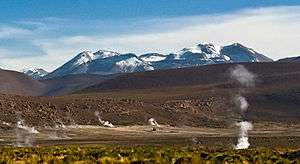Linzor
Volcán Linzor is a stratovolcano on the border between Bolivia and Chile. In its vicinity lie Laguna Colorada and Cerro del León.
| Volcán Linzor | |
|---|---|
 Volcán Linzor seen from the south at the El Tatio geo-thermal field. In the background the summit of the El Apagado Norte volcano. | |
| Highest point | |
| Elevation | 5,680 m (18,640 ft) [1] |
| Coordinates | 22°09′S 67°58′W [2] |
| Geography | |
| Location | Bolivia and Chile |
| Parent range | Andes |
| Geology | |
| Mountain type | Stratovolcano |
Geology
Regional
Since the late Oligocene, subduction of the Nazca Plate beneath the South America Plate has caused volcanism on the western edge of South America, including the formation of the Central Volcanic Zone.[3] The crust in the Central Andes contains both an upper felsic layer and a lower mafic layer and was partly assembled from numerous terranes during the Mesoproterozoic. The most important two form the Arequipa-Antofalla crustal domain.[4]
Local
Linzor volcano is part of the Central Volcanic Zone. The Andean Central Volcanic Zone has erupted large ignimbrites and lava flows. Dominant rocks are andesite and dacite.[3] One part of the Central Volcanic Zone is the Altiplano-Puna volcanic complex, a system of ignimbrite sheets and lava domes that was active between 8.4 and 2.9 million years ago and is underpinned by a layer of partially molten crust. In the Linzor area, volcanism is represented by the 8.3 million years old Sifon ignimbrite, Cerro Chillahuita and Cerro Chao.[4]
Linzor and other volcanoes in the neighbourhood are constructed by breccia, lava domes, lava flows, pyroclastic flows and breccia. The volcanoes are formed by basaltic andesite, andesite and dacite. Pyroxene andesite is the dominant component. The volcanoes are constructed on top of Miocene ignimbrites and are of Pleistocene-Holocene age.[5] An Inca sanctuary has been found on Linzor.[6]
Linzor is part of a north-south trending volcanic chain with San Pedro volcano[4] which was heavily glaciated in the past.[7] This chain is parallel to several Paleozoic faults in the region.[5] The Rio Toconce, a tributary of the Rio Salado and ultimately of the Loa River, originates at the foot of Linzor.[8]
References
- "Linzor". Smithsonian Institution Global Volcanism Program.
- "Volcán Linzor". GEOnet Names Server.
- Godoy et al. 2014, p. 24.
- Godoy et al. 2014, p. 25.
- Godoy et al. 2014, p. 26.
- Besom, Thomas (2013-04-15). Inka Human Sacrifice and Mountain Worship: Strategies for Empire Unification. UNM Press. p. 12. ISBN 9780826353085.
- Graf, K. (1991). "Ein Modell zur eiszeitlichen und heutigen Vergletscherung in der bolivianischen Westkordillere". Bamberger Geographische Schriften (in German). 11: 145. OCLC 165471239.
- Pell, Albert; Márquez, Anna; López-Sánchez, José Fermín; Rubio, Roser; Barbero, Mercedes; Stegen, Susana; Queirolo, Fabrizio; Díaz-Palma, Paula (2013-01-01). "Occurrence of arsenic species in algae and freshwater plants of an extreme arid region in northern Chile, the Loa River Basin". Chemosphere. 90 (2): 556–64. doi:10.1016/j.chemosphere.2012.08.028. hdl:2445/110162. PMID 22981629.
Sources
- Godoy, Benigno; Wörner, Gerhard; Kojima, Shoji; Aguilera, Felipe; Simon, Klaus; Hartmann, Gerald (2014-07-01). "Low-pressure evolution of arc magmas in thickened crust: The San Pedro–Linzor volcanic chain, Central Andes, Northern Chile". Journal of South American Earth Sciences. 52: 24–42. doi:10.1016/j.jsames.2014.02.004.